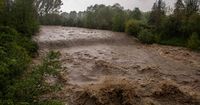The northern part of Italy and the broader Alps region are currently grappling with severe weather conditions, as heavy snowfall has created significant disruptions across the area. In higher elevations, precipitation is falling as snow, rendering numerous roads and railways impassable. The picturesque Swiss mountain village of Zermatt has been completely cut off from the outside world due to the relentless snowfall. Other Alpine villages are also facing accessibility challenges, with heavy snow accumulation and a heightened risk of avalanches leading to several ski villages experiencing power outages.
Météo France has issued a warning of avalanche danger with a code 5, which is the highest level of alert. Residents in affected areas have been advised to remain indoors until late afternoon due to the severe avalanche risk, which also extends to roadways. According to David Dehenauw, head of the Royal Meteorological Institute of Belgium (KMI), the highest peaks of the French Alps are currently blanketed with up to one meter of snow. This substantial snowfall is not just unusual for this time of year but is also notable in its overall volume.
In Italy, the situation has escalated to alarming levels, particularly in the northern regions. Dehenauw reported that over 480 millimeters of precipitation has fallen in the past 24 hours, a figure that exceeds half of the average annual rainfall for Belgium, which stands at 840 millimeters in Ukkel. The heavy rains and snowfall have led to flooding in several Italian villages, with the town of Macugnaga left isolated due to a landslide. In Ossola, located in the Italian region of Piedmont, the water level of the Toce river has surged to what officials describe as a 'worrying level,' prompting authorities to advise residents to seek refuge on the upper floors of their homes as a precautionary measure.
The cause of this severe weather can be traced back to a phenomenon known as a Genoa depression, a low-pressure area that has settled over the Gulf of Genoa. This weather system arises from the convergence of warm and cold air masses. Cold Atlantic air from France is deflected towards Italy by the Corsican high mountains, where it meets warm air above the Gulf of Genoa. This interaction creates a low-pressure system that is effectively trapped by the Alps, resulting in prolonged periods of precipitation.
Nicolas Roose, a weather analyst at MeteoSupport, explained that the Genoa depression is not an uncommon occurrence, as it can manifest in both winter and summer. He noted that at the beginning of winter, the Mediterranean Sea remains relatively warm, a condition exacerbated by the warming of seawater during the summer months. Roose added that this weather phenomenon is now more predictable than it has been in the past, with weather models accurately forecasting its development as early as the previous weekend.
Looking ahead, both Dehenauw and Roose indicate that the worst of the precipitation may be behind us. They anticipate that, compared to the current conditions, the next few days will see a reduction in rainfall and snowfall. Roose mentioned that the low-pressure system has begun to 'run out of steam,' with weather models suggesting precipitation may continue until Saturday, April 19, 2025, after which a stabilization of conditions is expected. However, fluctuations in weather patterns across France, Corsica, and the Mediterranean region are likely to persist into the following week.
As the precipitation zone gradually shifts towards the Balkans, concerns remain regarding the thick snow cover in the Alps. Roose warned that the snow that has accumulated will eventually melt, and as temperatures rise in the coming period, this could lead to increased water levels on the Rhine River during May and June.
In stark contrast to the current severe weather, Flemish tourists in the Alps have remarked on how the heavy snowfall sharply contrasts with the relatively mild weather conditions experienced just a week prior. Reports indicate that the snow has reached heights of up to 120 centimeters, creating a winter wonderland that has delighted some but also posed significant challenges for travel and daily life.
The ongoing severe weather in the Alps serves as a reminder of the complexities and unpredictabilities of climate patterns, particularly in light of changing global conditions. As communities grapple with the immediate impacts of this weather event, the focus will inevitably shift towards recovery and preparedness for future occurrences.




